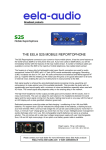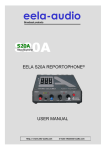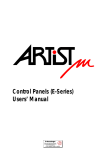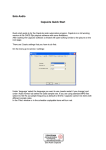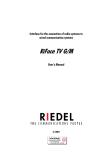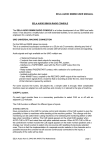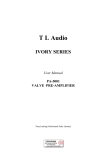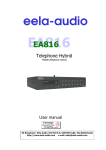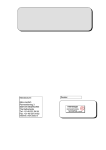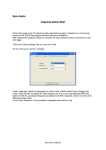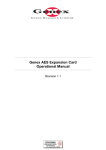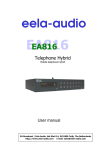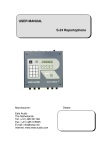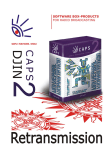Download Eela S25 manual - fra www.interstage.dk
Transcript
Eela Audio S25 ReportoPhone User Manual interstage Phistersvej 31, 2900 Hellerup, Danmark Telefon 3946 0000, fax 3946 0040 www.interstage.dk - pro audio with a smile EELA AUDIO S25 REPORTOPHONE® USERS MANUAL WARNING Do not expose this appliance to rain or moisture. To reduce the risk of electrical shock, do not remove cover. There are no user-serviceable parts inside. Do not attempt to repair the unit yourself, this voids the right of warranty. Refer servicing to qualified personnel. CE-Product This product is in conformity with the requirements of the CE directives. This product should only be installed and used in installations as specified in this manual and should only be used with the ancillary equipment and options and in the right environment according the recommendations. The supplier will not take any responsibility of damage to or induced by this product caused by using the equipment in any not specified application or connecting items or equipment, in any way or environment other than specified. General Information Cleaning Clean the outside of this product with a soft cloth. Do not use any cleaning detergents like alcohol, white spirit or ammonia based fluids to clean this product. This can severely damage the finish of the product. For waste separation: At the end of the lifecycle of this product or the batteries dispose it in accordance with local procedures for disposal of hazardous or chemical waste. Do not dispose the unit or batteries in the ordinary way, but if possible hand it in as Small Chemical Waste. EELA AUDIO S25 REPORTOPHONE® USERS MANUAL NL Thank you for the purchase of this S25 Reportophone. First read this manual carefully before starting to use the apparatus. Please keep this manual so you can refer to it at a later stage. User familiar with the S20A will find it easy to work with this S25 but it is strongly recommended to read the part about power supply and charging of the batteries. EELA AUDIO S25 REPORTOPHONE® USERS MANUAL Quick start: - Do read the information about batteries and charger. - Connect a dynamic or electret microphone to the XLR input and a suitable headphone to the Jack connector with lock. - Connect your mobile telephone with the appropriate cable. - Turn all 4 volume controls to the middle position. - Switch the unit on by briefly pushing the ‘on’button. The leftmost yellow LED will light. Watch the mobile telephone to display an external message. To switch the unit off push and hold the ‘on’button for a few seconds. - Dial a number to connect to the studio. - After a 10 minutes period of inactivity the unit will automatically switch off. EELA AUDIO S25 REPORTOPHONE® USERS MANUAL Important information about the batteries and charger: The S25 is supplied with and intended for use with a set of 4 AA-size NiMH batteries. As the unit is designed for portable use it is important to keep the batteries in the best possible condition. Therefor the unit has a carefully designed internal battery charger / conditioner with 2 processors to monitor the state and charging / recharging. Momentary pushing the on/off switch will switch the unit on. Holding the button for a few seconds will cause the unit to switch off. To preserve power the unit will automatically switch off if not active for more than approx. 10 minutes. It is not possible to use the S25 during charging of the batteries. A trade-off between optimum battery use, fast charging en best signal quality. Keep the batteries in the unit, avoid swapping. Over time the processor ‘learns’the state and condition, a process that has to start over upon swapping batteries. Accidentally opening and closing of the battery case will cause only one blue LED to light. Connecting the unit to an external power supply will bring back accurate display in a few minutes. If it becomes necessary to replace the batteries it is strongly recommended to use the same type and capacity as the original. The display of remaining capacity is adjusted for the type of batteries the unit is shipped with. You can use standard non-rechargeable batteries but you have to switch the charger off to avoid accidental charging of non-rechargeable batteries. A switch is hidden behind the hole on the left side panel. (The hole closest to the back of the unit) You can operate the switch with e.g. a pen or paperclip. The blue battery LED’s will extinguish in this mode. - Charger on / of - Discharge switch Preferably use the wide range 12V DC power supply provided with the unit. However the unit will accept an input voltage in the range of 12 to approx. 28 Volts. This will allow charging the unit in a car (12V) or even a truck (24V). A car battery cable is available as an option. Charging current is up to 1,5A. With one charge of the batteries the unit can be used continuously for more than 10 hours. Empty batteries will charge in a few hours depending on type and capacity, a fast rush charge (e.g. in a car) of 15 minutes will EELA AUDIO S25 REPORTOPHONE® USERS MANUAL charge the power supply enough for one-hour use. These figures largely depend on the make and type of batteries used. Batteries with a larger capacity will have to be charged over a longer period. 5 blue LED’s indicate the state of the battery set. All lights on means fully charged, when the first blue LED start flashing there is power for approx. 10 minutes left. To safe power these LED’s will extinguish after a given period. Momentary pushing the on/off switch will bring the display back on. A bi-coloured LED (left of the 5 blue LED’s) indicates charging or de-charging: Red the unit is de-charging, green is charging, a blinking green LED indicates trickle charging. A new set of batteries will reach full capacity after a few charging and de-charging cycles. You can put the unit in de-charging mode by momentary pressing the red hidden switch on the left side of the unit with e.g. a pen. In this mode the external power supply has to be connected to the unit. Removing the external power resets this state. A full de-charging / charging cycle will take up to 12 hours. The fast charging process will need minimum charged batteries. Please allow extra time for new - or really empty - rechargeable batteries, as they will be charged with a very small current until a minimum voltage is reached. The green LED will blink while this process is going on. It can occur that the charging stops at the transit of slow charge to fast charge. In that case reset the unit by shortly removing the power supply. Battery holder is located on the right side of the unit and - it is not easy - can be opened without tools. Mains adapter (IU15-2120120-WP). The S25 Reportophone is standard shipped with a wide range mains adapter 100V – 240V AC 50/60Hz 0,5A. This adapter supplies the S25 with a 12V DC voltage. Please check if the rated mains voltage of the adapter is suited for the local mains voltage. The adapter is shipped with 3 interchangeable mains plugs for Euro, UK and US/Japanese style wall outlets. To remove the mains plug from the adapter, firmly push the knob above the label and slide the head towards the top of the unit. EELA AUDIO S25 REPORTOPHONE® USERS MANUAL APPLICATIONS The EELA AUDIO S25 REPORTOPHONE® is a universal, multifunctional tool for the radio reporter to be used with a portable telephone. Make sure you order a connection cable to match your type of cell-phone. The S25 has to be used with a portable telephone in "external" mode e.g. "hands-free", "headset", "remote mode", or "carkit". Most, but not all, phones will have an indication on the display. Some models switch to "external mode" upon connecting the single cable to the telephone. Others you will also need to connect the S25 and some require the S25 to be switched on also. A number of phones require an on or off pulse. You will have to push the on/off button of the S25 momentary to toggle the phone to internal / external mode. The on/off button of the S25 can also be used with some phones to connect / disconnect. Except for the primary purpose, sending program-contributions to the studio via the public mobile telephone system, a number of extra facilities are available, shown very useful in practice. These facilities are: 1. Making a connection with the studio and sending contributions via microphone and/or tape with monitoring of the return signal, to be mixed with the direct signal. The connection has to be made with your mobile telephone. 2. Making a connection for a telephone-interview and recording this on a connected audio recorder. The balance between the own contribution (via the microphone) and the incoming contribution from the telephone can be adjusted for optimum results. 3. The use of the S25 REPORTOPHONE as portable mixer for recording with inputs for microphone and line/tape with internal compressor / limiter for level control, a feature very useful as addition to many reporter machines without a good automatic level control facility. EELA AUDIO S25 REPORTOPHONE® USERS MANUAL Connections: All connections are located on the back panel of this REPORTOPHONE®', with professional, heavy-duty connectors for maximum reliability. Microphone: Balanced XLR-type input for dynamic or electret microphone Headphone: ¼”Jack with lock, stereo / 2 channel Line input: ¼”Jack, balanced, line level +6 dBU Line output: ¼”Jack, balanced, line level +6 dBU Both professional sources with high level and balanced outputs as consumer equipment with lower level and unbalanced character with higher impedance’s can be used without problems. Electrical details inputs and line output: Signal: XLR-type: Screen Pin 1 In phase signal (+) out Pin 2 Phase signal (-) Pin 3 ¼”Jack: sleeve tip ring Pin 1 and pin 3 have to be wired together for unbalanced connections. HEADPHONE OUTPUT (HPH) This is a 1/4" stereo jack connection as used for stereo headphones. The output signal is MONO, but a stereo headphone is recommended, preferably with an impedance of 600 Ohm for the best results. A mono headphone, like one of a headset combination has to be wired with "signal" on TIP and RING and "ground" to SLEEVE. This "ground" may not be connected with the screen of the microphone input because of the balanced character of the headphone output with signal on both wires, This has been done to produce the maximum output level and the lowest current consumption with the given battery voltage. The use of lower impedance headphones is possible but will have slightly less output level and will draw slightly more current. To release the headphones push the red button and pull the connector out. EELA AUDIO S25 REPORTOPHONE® USERS MANUAL S25 back connections PWR, external power connector 12V to 28 V DC, up to 1,5 Amp. Green Power LED, indicates an external power supply is active. Mobile Telephone connector, 15-way D-type. For available cables see separate list. Phones, headphone connector with lock. Line in, high level balanced line input. Line out, high level line output for a recording device. Mic, balanced microphone input . EELA AUDIO S25 REPORTOPHONE® USERS MANUAL Front panel controls To switch the unit on briefly push the (ON) button. To switch the unit off push and hold the (ON) button for a few seconds. The yellow leftmost LED will indicate the unit on. Briefly tapping the (ON) button while the unit is on will switch the battery level indication on. It also toggles a contact to put certain telephones in external mode. The use of this contact depends on the telephone model used. LED meterbar consists of 4 LED’s to aid adjusting the input level. Only yellow the level is too low, red is too high. An optimum input level is obtained if one or 2 green LED’s light in the rhythm of the input signal. This is the optimum modulation. In case of unexpected high peaks, they will be "caught" by the built-in compressor / limiter, so distortion is prevented. The unit will switch off if there has been no “green” indication for a period of approx. 10 minutes. (Both green LED's on) Microphone (MIC) to adjust the microphone input level. Line (LINE) adjusts the line input level. The range is more than enough to use both balanced as well as unbalanced input sources. In case of playback a line signal only to the studio it is strongly recommended to turn the MIC volume down to prevent surrounding noise to mix with the line signal. Balance (MIX-RET) adjust the balance between the mix of input signals (microphone and line) and the signal coming back from the studio (return signal). Often the volume of the return signal also depends on the volume setting of the mobile phone. Headphone (PHONES) regulates the volume of the headphone. USE Available are: 1. MICROPHONE INPUT (MIC) Made via a female XLR, balanced for using almost any kind of dynamic or (professional) electret microphone. The sensitivity can be controlled such, that optimum modulation can be achieved in almost any situation. EELA AUDIO S25 REPORTOPHONE® USERS MANUAL 2. LINE INPUT (LINE) On a ¼” jack and balanced. Both professional sources with high level and balanced outputs as consumer equipment with lower level and unbalanced character with higher impedance’s can be used without problems. 3. RECORD OUTPUT (OUT) This is an unbalanced output on a ¼” jack for connection to a line-input of a recorder for recording of the mix of the contribution of the telephone line and the microphone/tape signal, the same signal that can be heard on the headphone output. EELA AUDIO S25 REPORTOPHONE® USERS MANUAL OPERATION 1. DIRECT CONTRIBUTION TO THE STUDIO DIALLING Connect your mobile telephone with the appropriate cable. Turn all 4 volume controls to the middle position. Switch the unit on by briefly pushing the ‘on’button. Watch the mobile telephone to display an external message. With you mobile telephone dial a number to connect to the studio. You are now able to communicate with the studio. SETTING THE MICROPHONE LEVEL (MIC CONTROL) Speak into the microphone with the expected loudness and adjust the MIC control up to the position, that one or two green LED's light in the rhythm of the speech with occasional action of the red LED in peaks. This is the optimum modulation with the least side effects and the strongest signal in the studio. In case of unexpected high peaks, they will be "caught" by the compressor/limiter, so distortion is prevented. SETTING THE LINE LEVEL (LINE CONTROL) The same rules are valid here as for setting the microphone level. MIX CONTROL This control has influence both on the RECORD output and on the HEADPHONE MONITORING. With the control in the CCW position (MIX), only the output of the mixer (mic. and/or line) can be heard and recorded; with the control clockwise (TEL) then only the signal from the telephone line is available. A comfortable listening is often achieved by setting the MIX control in the middle position, so adding enough high quality signal from the mixer for comfortable listening. Note: The volume of the return signal also depends on the loudspeaker volume control of the portable telephone! SETTING HEADPHONE LEVEL (PHONES) This can be set to the taste or the need of the user. 2. RECORDING A TELEPHONE INTERVIEW The basic settings are the same as those for a contribution to the studio with an extra for recording the item. SETTING THE RECORDING LEVEL The recording output level of the REPORTOPHONE® can not be set, so this has to be done on the recording device. The best time to do this is during the first conversation. EELA AUDIO S25 REPORTOPHONE® USERS MANUAL The MIX control allows for setting the balance between the own contribution and the one from the caller and this has to be done for equal loudness. Checking is easy, because the same mix appears on the headphones. With really low level from the incoming signal, turn the MIX control more CW, for too strong signals more CCW. 3. USE AS MIXER Also here the basics for setting the levels of microphone- and line input and the recording alignment are the same as described above. In order to avoid possible noise from the telephone set the MIX control to the full counter clockwise (= MIX) position. interstage Phistersvej 31, 2900 Hellerup, Danmark Telefon 3946 0000, fax 3946 0040 www.interstage.dk - pro audio with a smile NiMH Charging The Eela Audio S25 Reportophone is used with metal hydride, NiMH, batteries. There are advantages of using these batteries but special care has to be taken when charging these. The main benefits of NiMH batteries over NiCad are that they do not suffer from the memory effect and the extended capacity. And there is also the advantage that NiMH batteries are more environmental friendly. The charging efficiency of NiMH batteries is approx. 50%, meaning that you must put in double energy of what you get out. This also depends on temperature and charging current. The faster you charge the worse this gets. A safe fast charging current is approx. half the rated capacity per hour. A safe way to charge the batteries without damaging them by overcharging is a charge rate of max. 10%. Empty cells with a capacity of 2000 mAh will have to charge for 25 hours. This is not acceptable for a professional user. NiMH batteries discharge over time. Unfortunately this self-discharging is not equal for all batteries and there are considerable differences in discharging between cells even in the same package. This is the main reason these batteries are not charged out of the package. Make sure new or batteries that are not use over a longer period of time are discharged before you start using them in order to prevent individual cells getting not completely charged or overcharged. A few charging and discharging cycles will smoothen out these differences in cells. This will also improve maximum capacity of new cells. Fast charging of new or deep discharged batteries will damage the batteries thus shortening the lifetime. The charging process starts with about 10% of the rated capacity per hour until the voltage exceeds 0.95 Volt per cell. On the S25 a blinking green LED indicates this state. This slow start can take up to one hour for new batteries. To detect if the batteries are fully charged a combination of 2 methods is used. If batteries are near full a voltage drop can be detected known as the 'minus delta V bump'. Unfortunately the minus delta V bump that is indicative of end-of-charge is much less pronounced in NiMH than NiCad, and it is very temperature dependent. To make matters worse, new NiMH batteries can exhibit bumps in the curve early in the cycle, particularly when cold. This is the reason in rare cases charging can stop unexpectedly at the beginning of the fast charging. Unplugging and connecting the power supply will restart the charging mode. We have chosen to switch the unit off when the power supply is plugged in. Variable current consumption of a unit in use will make it too difficult to detect the delta V bump. Take special care when charging the S25 in low or high temperatures. The unit will stop charging outside a temperature range of approx. 0o to + 40 o C. NiMH are sensitive to damage on overcharge when the charge rate is over 10%. As the battery reaches end-of-charge oxygen starts to form at the electrodes. The built-in catalyst in the cells recombines this oxygen. This chemical reaction creates heat, which is measured with a temperature sensor. In the S25 a temperature increase of a few degrees in a relative short time (∆T / ∆t) will also end the charging process. As a precaution there is also a time limit. Charging time is limited but of course this is only valid if you are charging empty batteries. Display remaining capacity: The easiest way to have an accurate display of the remaining capacity is to use dedicated battery packs or built-in batteries as many manufacturers of household appliances, cameras or cell phones do. With the S25 we have chosen to use standard rechargeable batteries that can be exchanged for non-rechargeable in an emergency. Taking the above into consideration and the fact that the voltage of the cells are temperature dependant it is not easy to built a reliable display to indicate the remaining operating time. The indication of the display of the S25 is adjusted to the type of cells it is initially shipped with. The indication will be slightly inaccurate if the batteries will be replaced with another than the rated capacity. interstage Phistersvej 31, 2900 Hellerup, Danmark Telefon 3946 0000, fax 3946 0040 www.interstage.dk - pro audio with a smile EELA AUDIO S25 REPORTOPHONE® TECHNICAL INFO Disable the auto switch off function: Momentary pushing the on/off switch will switch the unit on. Holding the button for a few seconds will cause the unit to switch off. To preserve power the unit will automatically switch off if not active for more than approx. 10 minutes. Your can disable this auto off function by changing an internal setting. PCB V2 (SN > 100) S25PCB V2 On the PCB between the battery holder and the rear there is an empty solder pad with an interruption as shown in the picture. Solder the 2 halves together to disable the auto-shut-off function when used with batteries. EELA AUDIO Horn 6 Haps The Netherlands +31485-310346 S25UK 1-09-2005 EELA AUDIO S25 REPORTOPHONE® TECHNICAL INFO Use as a stationary hybrid: - Charger on / of - Discharge switch PCB version 2 (SN > 099) can also be used as a stationary hybrid e.g. in areas without a standard telephone infrastructure. A switch is hidden behind the hole on the left side panel. (The hole closest to the back of the unit) This is the charger on/off switch. You can operate the switch with e.g. a pen or paperclip. The blue battery LED’s will extinguish in this mode. In this mode you can also use this unit with the external power supply connected and no batteries inside. The unit will not switch off automatically. S25V2 EELA AUDIO Horn 6 Haps The Netherlands +31485-310346 S25UK 1-09-2005

















